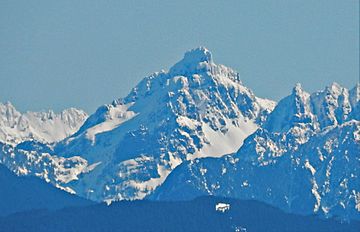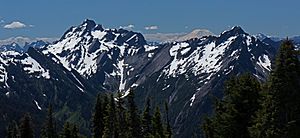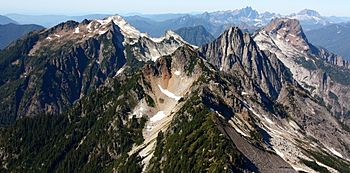Del Campo Peak facts for kids
Quick facts for kids Del Campo Peak |
|
|---|---|

Del Campo Peak seen from Lake Stevens, WA
|
|
| Highest point | |
| Elevation | 6,610 ft (2,010 m) |
| Prominence | 2,210 ft (670 m) |
| Isolation | 3.84 mi (6.18 km) |
| Geography | |
| Location | Snohomish County, Washington, U.S. |
| Parent range | Cascade Range |
| Topo map | USGS Monte Cristo |
| Climbing | |
| First ascent | 1912, J.A. Juleen |
| Easiest route | Scrambling |
Del Campo Peak is a tall mountain in Washington state. It is located in Snohomish County. This peak is part of the western North Cascades mountain range.
You can find it south of Barlow Pass. It is also near the Monte Cristo area. The mountain is on land managed by the Mount Baker-Snoqualmie National Forest. Its name comes from an old mining claim on its side.
The closest mountain is Gothic Peak, about 0.5 miles (0.8 km) southwest. Foggy Pass is the low area between these two peaks. Foggy Lake sits below Del Campo Peak's south side. Water from the mountain flows into this lake. This water then drains into the South Fork Sauk River. Water from the west side of the mountain flows into the Sultan River. Water from the north side goes into the Stillaguamish River. The best time to climb Del Campo Peak is from July to September.
Contents
Mountain History: How Del Campo Got Its Name
Dr. Harry B. Hinman suggested the name for the mountain in 1917. He was the Chairman of The Everett Mountaineers. The U.S. Board on Geographic Names officially approved the name in 1918. The first person to climb Del Campo Peak was J.A. Juleen. He made this first climb in 1912.
Weather and Climate Around Del Campo Peak
Del Campo Peak is in a marine west coast climate zone. This means it has mild, wet winters and cool, dry summers. Most weather systems come from the Pacific Ocean. They travel northeast towards the Cascade Mountains.
As these weather systems reach the North Cascades, the mountains force the air upward. This causes the air to cool and drop its moisture. This moisture falls as rain or snowfall on the Cascades. This process is called Orographic lift. Because of this, the western side of the North Cascades gets a lot of rain and snow.
During winter, the snow tends to be wet and heavy. This can create a high risk of avalanches. Temperatures rarely go below 0°F (-18°C) or above 80°F (27°C). Winters are usually cloudy. However, during summer, high pressure systems over the Pacific Ocean bring clear skies. The months from July to September offer the best weather for visiting or climbing the peak.
Geology: How the North Cascades Were Formed

The North Cascades have very rugged land. You can see sharp peaks, long ridges, and deep glacial valleys. These features were created by geological events millions of years ago. These events caused big changes in elevation. This led to different climates and types of plants in the area.
The Cascade Range began forming millions of years ago. This was during the late Eocene Epoch. The North American Plate was moving over the Pacific Plate. This caused many volcanic eruptions. Glacier Peak, a large stratovolcano, started forming later. It is about 18 miles (29 km) east-northeast of Del Campo Peak. Also, small pieces of the Earth's crust, called terranes, helped form the North Cascades. This happened about 50 million years ago.

During the Pleistocene period, over two million years ago, glaciers moved across the land many times. As they moved, they carved out the landscape. They left behind piles of rock debris. The U-shaped valleys you see today were formed by these glaciers. The rising of the land and faults, combined with glaciation, created the tall peaks and deep valleys of the North Cascades.
More About Del Campo Peak
- Del Campo Peak weather forecast: Mountain Forecast
- Del Campo Peak from above: PBase aerial photo




